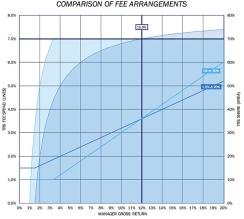The new 2-and-20 is 1-or-30, at least at Teacher Retirement System of Texas and other pension funds adopting the latest fee model.
In the early spring of 2016, the hedge fund team at the Texas pension plan had the same problem faced by many large investors globally: As gross hedge fund returns fell, net returns for investors fell even further because of fees they paid.
“Our basic philosophy is that the approximate split of alpha between investors and managers should be 70 percent to 30 percent,” says Brad Gilbert, director of hedge funds at Texas Teachers, which oversees $133 billion of assets.
"But as returns have been lower, we’ve seen split of alpha that’s inconsistent with that standard. In a low-return environment, the deal breaks downs,” he says. “If the manager is earning 8 to 10 percent net annual returns, 70-30 is about the split. But in the last few years, 50 to 75 percent has been going to the manager, and we feel like that’s not a split that is sustainable to the industry.”
Some of Texas Teachers’ highest-profile peers, including California Public Employees’ Retirement System and New York City Employee Retirement System, have exited hedge funds entirely after suffering the short end of the alpha stick. But Gilbert and his colleagues wanted to fix the transaction, and arrived at a goal: 70 percent of alpha ought to go to them — bull markets or bear. Then they solved for that.
The first iteration of its alpha-optimized fee model succeeded with one of the fund’s existing managers. “TRS negotiated a great deal,” says Jonathan Koerner, who serves as head of implementation for hedge fund specialist consultant Albourne Partners, and previously spent seven years on the asset allocation side of the business at Utah Retirement Systems. He declined to name the fund manager.
Still, TRS’ investment committee thought they should do better. Members rejected the model, and sent Gilbert and company back to the drawing board. Achieving the team’s explicit 70-30 split goal meant the manager would have to post a 12 percent gross return every year — “which is a big assumption,” Koerner says when asked about it. “So the call came to us to help with this goal. I didn’t necessarily have a solution in mind, but had some ideas.”
An estimated “200 to 300 hours” of work later, the 1-or-30 model was ready for primetime:
* 1 percent management fee: “The easiest way to get alignment and not pay for underperformance is to have a zero percent management fee,” says Koerner, “but I’m not sure as an investor you even want that. A big part of arriving at 1-or-30 was just reframing away from 2-and-20.” Plus, adds TRS Senior Managing Director Dale West, “Nobody can turn this management fee into a profit center.”
* Management fee hurdle: Under the 1-or-30 structure, management fees are an advance on future performance fees. TRS won’t pay performance fees until 30 percent of gross alpha exceeds 1 percent of net asset value. As West puts it, “you can almost think of a management fee as a draw on a future performance fee.”
*30 percent performance fee: “The break even point between 1.5-and-20 and 1-or-30 is 12.5 percent gross returns, 8.6 percent net returns,” says Koerner. “The managers confident that they can achieve beyond that, once they understand the model, they jump on it. It’s upside for them.”
*Beta and cash hurdles: TRS does not believe in paying hedge fund fees for beta or cash, according to internal documents. “We weren’t aiming for a fee cut per se,” explains Gilbert. “We’re happy to pay if there’s genuine value-added.” And installing a hurdle over whatever beta may embedded within a hedge fund’s strategy ensures TRS does only pay for value-add, not reaping an exposure that could be delivered more cheaply.
Most managers that Gilbert, West, and Koerner have pitched their formula to like it, perhaps after a bit of an adjustment period. It’s a shift from the traditional 2 percent management fee and 20 percent performance fee.

Source: Teacher Retirement System of Texas“In the initial conversation, there’s always some defensiveness,” according to Gilbert. “It’s a little bit more complex, and some managers haven’t worked with a hurdle rate. We let the managers see all the tools we’re using and model their past returns, to show them what it would look like over a longer term cycle. Then eventually, they get excited about it.”
Or, rather, most of them get excited about it.
“The acceptance rate has been very high, and the majority of our hedge fund assets are now with managers on this fee structure,” Gilbert says. “It’s definitely the new standard, and we’re not bringing anybody to the investment committee that is not open to it.” And those on the existing roster who weren’t open to it? “In some cases, we have parted ways.”






